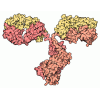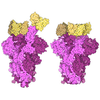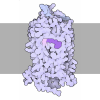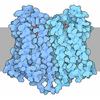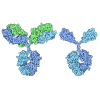[English] 日本語
 Yorodumi
Yorodumi- PDB-9ijs: Cryo-EM structure of the orphan GPR52 bound to beta-arrestin 1 in... -
+ Open data
Open data
- Basic information
Basic information
| Entry | Database: PDB / ID: 9ijs | ||||||
|---|---|---|---|---|---|---|---|
| Title | Cryo-EM structure of the orphan GPR52 bound to beta-arrestin 1 in ligand-free state | ||||||
 Components Components |
| ||||||
 Keywords Keywords | MEMBRANE PROTEIN/IMMUNE SYSTEM / Complex / membrane protein / GPCR / arrestin / MEMBRANE PROTEIN-IMMUNE SYSTEM complex | ||||||
| Function / homology |  Function and homology information Function and homology informationangiotensin receptor binding / G protein-coupled photoreceptor activity / cellular response to light stimulus / TGFBR3 regulates TGF-beta signaling / Activation of SMO / negative regulation of interleukin-8 production / G protein-coupled receptor internalization / arrestin family protein binding / Lysosome Vesicle Biogenesis / negative regulation of NF-kappaB transcription factor activity ...angiotensin receptor binding / G protein-coupled photoreceptor activity / cellular response to light stimulus / TGFBR3 regulates TGF-beta signaling / Activation of SMO / negative regulation of interleukin-8 production / G protein-coupled receptor internalization / arrestin family protein binding / Lysosome Vesicle Biogenesis / negative regulation of NF-kappaB transcription factor activity / positive regulation of cardiac muscle hypertrophy / stress fiber assembly / Golgi Associated Vesicle Biogenesis / positive regulation of Rho protein signal transduction / pseudopodium / negative regulation of interleukin-6 production / positive regulation of receptor internalization / negative regulation of Notch signaling pathway / enzyme inhibitor activity / phototransduction / insulin-like growth factor receptor binding / clathrin-coated pit / negative regulation of protein ubiquitination / GTPase activator activity / Activated NOTCH1 Transmits Signal to the Nucleus / cytoplasmic vesicle membrane / locomotory behavior / G protein-coupled receptor binding / G protein-coupled receptor activity / Signaling by high-kinase activity BRAF mutants / MAP2K and MAPK activation / positive regulation of protein phosphorylation / Signaling by RAF1 mutants / Signaling by moderate kinase activity BRAF mutants / Paradoxical activation of RAF signaling by kinase inactive BRAF / Signaling downstream of RAS mutants / endocytic vesicle membrane / Signaling by BRAF and RAF1 fusions / Cargo recognition for clathrin-mediated endocytosis / protein transport / Thrombin signalling through proteinase activated receptors (PARs) / Clathrin-mediated endocytosis / cytoplasmic vesicle / ubiquitin-dependent protein catabolic process / G alpha (s) signalling events / molecular adaptor activity / proteasome-mediated ubiquitin-dependent protein catabolic process / transcription coactivator activity / positive regulation of ERK1 and ERK2 cascade / Ub-specific processing proteases / protein ubiquitination / nuclear body / G protein-coupled receptor signaling pathway / response to xenobiotic stimulus / Golgi membrane / lysosomal membrane / ubiquitin protein ligase binding / regulation of transcription by RNA polymerase II / chromatin / signal transduction / positive regulation of transcription by RNA polymerase II / nucleoplasm / nucleus / plasma membrane / cytosol / cytoplasm Similarity search - Function | ||||||
| Biological species |  Homo sapiens (human) Homo sapiens (human)synthetic construct (others) | ||||||
| Method | ELECTRON MICROSCOPY / single particle reconstruction / cryo EM / Resolution: 3.64 Å | ||||||
 Authors Authors | Lin, X. / Xu, F. | ||||||
| Funding support |  China, 1items China, 1items
| ||||||
 Citation Citation |  Journal: Cell Res / Year: 2025 Journal: Cell Res / Year: 2025Title: Constitutive arrestin recruitment by orphan GPR52 via an atypical binding mode. Authors: Xi Lin / Xiaohu Wei / Ning Pu / Ling Wang / Zhibin Zhang / Cuixia Li / Yang Yue / Junlin Liu / Qiwen Tan / Qianqian Sun / Fei Xu /  | ||||||
| History |
|
- Structure visualization
Structure visualization
| Structure viewer | Molecule:  Molmil Molmil Jmol/JSmol Jmol/JSmol |
|---|
- Downloads & links
Downloads & links
- Download
Download
| PDBx/mmCIF format |  9ijs.cif.gz 9ijs.cif.gz | 160.8 KB | Display |  PDBx/mmCIF format PDBx/mmCIF format |
|---|---|---|---|---|
| PDB format |  pdb9ijs.ent.gz pdb9ijs.ent.gz | 116.8 KB | Display |  PDB format PDB format |
| PDBx/mmJSON format |  9ijs.json.gz 9ijs.json.gz | Tree view |  PDBx/mmJSON format PDBx/mmJSON format | |
| Others |  Other downloads Other downloads |
-Validation report
| Summary document |  9ijs_validation.pdf.gz 9ijs_validation.pdf.gz | 1.3 MB | Display |  wwPDB validaton report wwPDB validaton report |
|---|---|---|---|---|
| Full document |  9ijs_full_validation.pdf.gz 9ijs_full_validation.pdf.gz | 1.3 MB | Display | |
| Data in XML |  9ijs_validation.xml.gz 9ijs_validation.xml.gz | 34.8 KB | Display | |
| Data in CIF |  9ijs_validation.cif.gz 9ijs_validation.cif.gz | 51.4 KB | Display | |
| Arichive directory |  https://data.pdbj.org/pub/pdb/validation_reports/ij/9ijs https://data.pdbj.org/pub/pdb/validation_reports/ij/9ijs ftp://data.pdbj.org/pub/pdb/validation_reports/ij/9ijs ftp://data.pdbj.org/pub/pdb/validation_reports/ij/9ijs | HTTPS FTP |
-Related structure data
| Related structure data |  60643MC  9ijrC M: map data used to model this data C: citing same article ( |
|---|---|
| Similar structure data | Similarity search - Function & homology  F&H Search F&H Search |
- Links
Links
- Assembly
Assembly
| Deposited unit | 
|
|---|---|
| 1 |
|
- Components
Components
| #1: Protein | Mass: 42400.555 Da / Num. of mol.: 1 Source method: isolated from a genetically manipulated source Source: (gene. exp.)  Homo sapiens (human) / Gene: GPR52 / Production host: Homo sapiens (human) / Gene: GPR52 / Production host:  |
|---|---|
| #2: Protein | Mass: 45148.371 Da / Num. of mol.: 1 Source method: isolated from a genetically manipulated source Source: (gene. exp.)  Homo sapiens (human) / Gene: ARRB1, ARR1 / Production host: Homo sapiens (human) / Gene: ARRB1, ARR1 / Production host:  |
| #3: Antibody | Mass: 28010.102 Da / Num. of mol.: 1 Source method: isolated from a genetically manipulated source Source: (gene. exp.) synthetic construct (others) / Production host:  |
| Has ligand of interest | N |
| Has protein modification | Y |
-Experimental details
-Experiment
| Experiment | Method: ELECTRON MICROSCOPY |
|---|---|
| EM experiment | Aggregation state: PARTICLE / 3D reconstruction method: single particle reconstruction |
- Sample preparation
Sample preparation
| Component | Name: The complex of GPCR with arrestin / Type: COMPLEX / Entity ID: #1-#2 / Source: MULTIPLE SOURCES |
|---|---|
| Source (natural) | Organism:  Homo sapiens (human) Homo sapiens (human) |
| Source (recombinant) | Organism:  |
| Buffer solution | pH: 7.5 |
| Specimen | Embedding applied: NO / Shadowing applied: NO / Staining applied: NO / Vitrification applied: YES |
| Vitrification | Cryogen name: ETHANE |
- Electron microscopy imaging
Electron microscopy imaging
| Experimental equipment |  Model: Titan Krios / Image courtesy: FEI Company |
|---|---|
| Microscopy | Model: FEI TITAN KRIOS |
| Electron gun | Electron source: OTHER / Accelerating voltage: 300 kV / Illumination mode: OTHER |
| Electron lens | Mode: OTHER / Nominal defocus max: 2200 nm / Nominal defocus min: 700 nm |
| Image recording | Electron dose: 60 e/Å2 / Film or detector model: GATAN K3 (6k x 4k) |
- Processing
Processing
| EM software | Name: PHENIX / Category: model refinement | ||||||||||||||||||||||||
|---|---|---|---|---|---|---|---|---|---|---|---|---|---|---|---|---|---|---|---|---|---|---|---|---|---|
| CTF correction | Type: PHASE FLIPPING ONLY | ||||||||||||||||||||||||
| 3D reconstruction | Resolution: 3.64 Å / Resolution method: FSC 0.143 CUT-OFF / Num. of particles: 136991 / Symmetry type: POINT | ||||||||||||||||||||||||
| Refine LS restraints |
|
 Movie
Movie Controller
Controller



 PDBj
PDBj